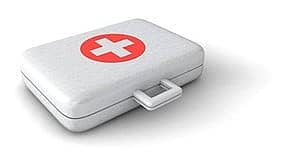Does your company offer first aid and CPR training to employees on a voluntary basis? If an AED is present in the company’s space, CPR and AED training is required. Even if your company doesn’t have an AED or requires employees to respond to medical emergencies, it’s a good idea to offer first aid and CPR training on a voluntary basis.
Offering CPR and first aid training, even when an AED is not present, is not only best practice but can also be required by regulation. OSHA’s Medical Services and First Aid Standard (29 CFR 1910.151) states “In the absence of an infirmary, clinic, or hospital in near proximity to the workplace which is used for the treatment of all injured employees, a person or persons shall be adequately trained to render first aid. Adequate first aid supplies shall be readily available.”
What is considered near proximity?
OSHA interprets the term near proximity to mean that emergency care must be available within no more than 3 to 4 minutes from the workplace. This is because, for serious injuries such as those involving stopped breathing, cardiac arrest, or uncontrolled bleeding, first aid treatment must be provided within the first few minutes to avoid permanent medical impairment or death.
What is considered a suitable provider of emergency medical services?
OSHA’s interpretation is that the reasonable availability of a trained emergency service provider, such as fire department paramedics or EMS responders, would be the equivalent of an infirmary, clinic, or hospital. Emergency medical services can be provided either onsite or by transporting the employee to an off-site facility.
OSHA also requires that employers take appropriate steps prior to any emergency (such as making arrangements with the service provider) to make sure that emergency medical assistance will be promptly available (i.e., within 3 to 4 minutes) when needed.
How many employees need to be first aid trained?
Where first aid training is required, a minimum of one trained employee is required to be onsite at all times. Best practice would be to have two or more first aid trained individuals to make sure there’s adequate coverage.
It’s important to keep in mind that any employee trained in first aid that has been identified by the employer as being responsible for rendering medical assistance as part of his or her job duties is covered by the Bloodborne Pathogen Standard (29 CFR 1910.1030).
What about CPR and AED training?
OSHA recommends that CPR training be included as part of first aid training and it is a specific requirement of some standards such as Permit-Required Confined Spaces (29 CFR 1910.146). OSHA does not specifically require that AED training be provided, although they do consider including AED training as a best practice. In many states including Massachusetts, if an AED is present onsite, both CPR and AED training is required.
For additional information on training requirements for first aid, CPR, and AEDs, or for help coordinating the appropriate training for your facility, please email us at [email protected]
This blog was written by Beth Graham, our Associate Director of Quality, Research, and Training.

